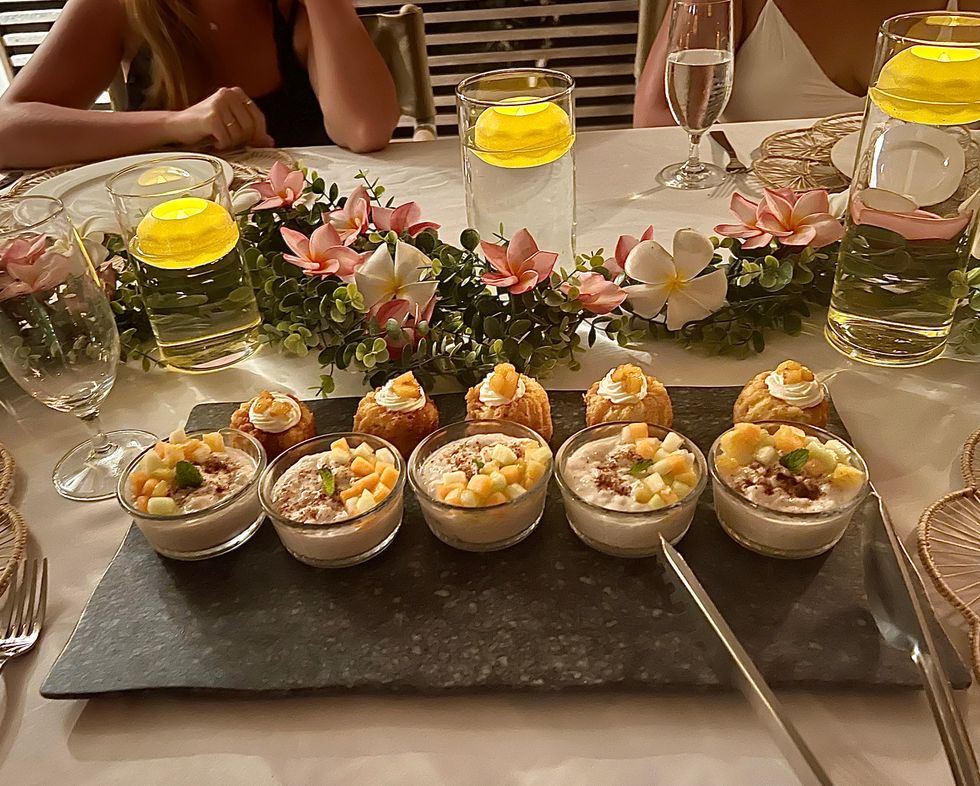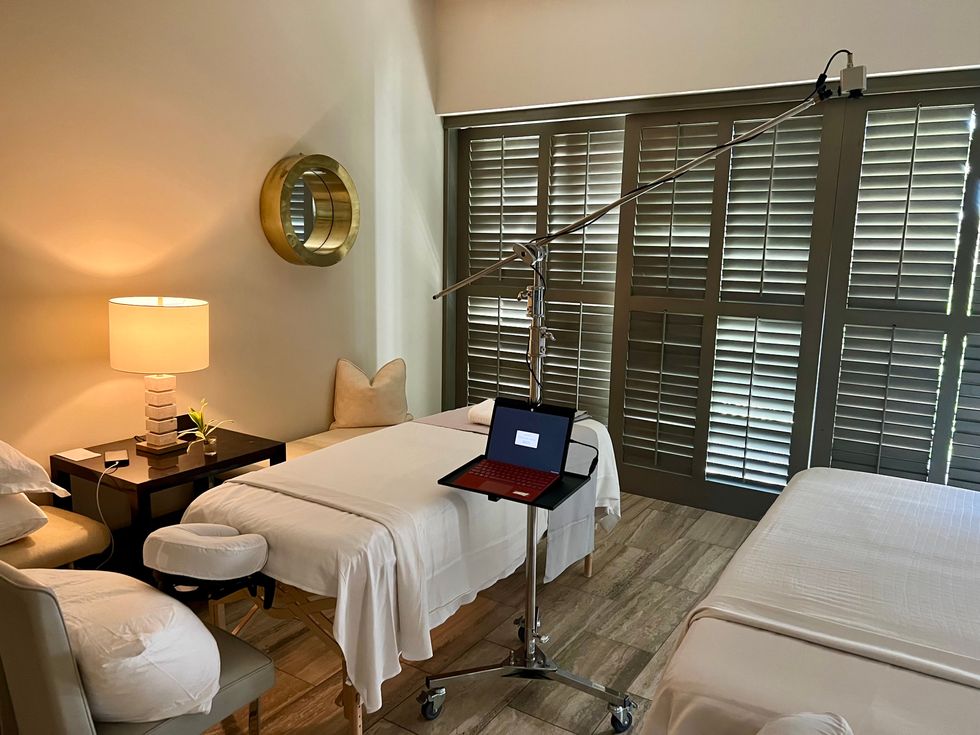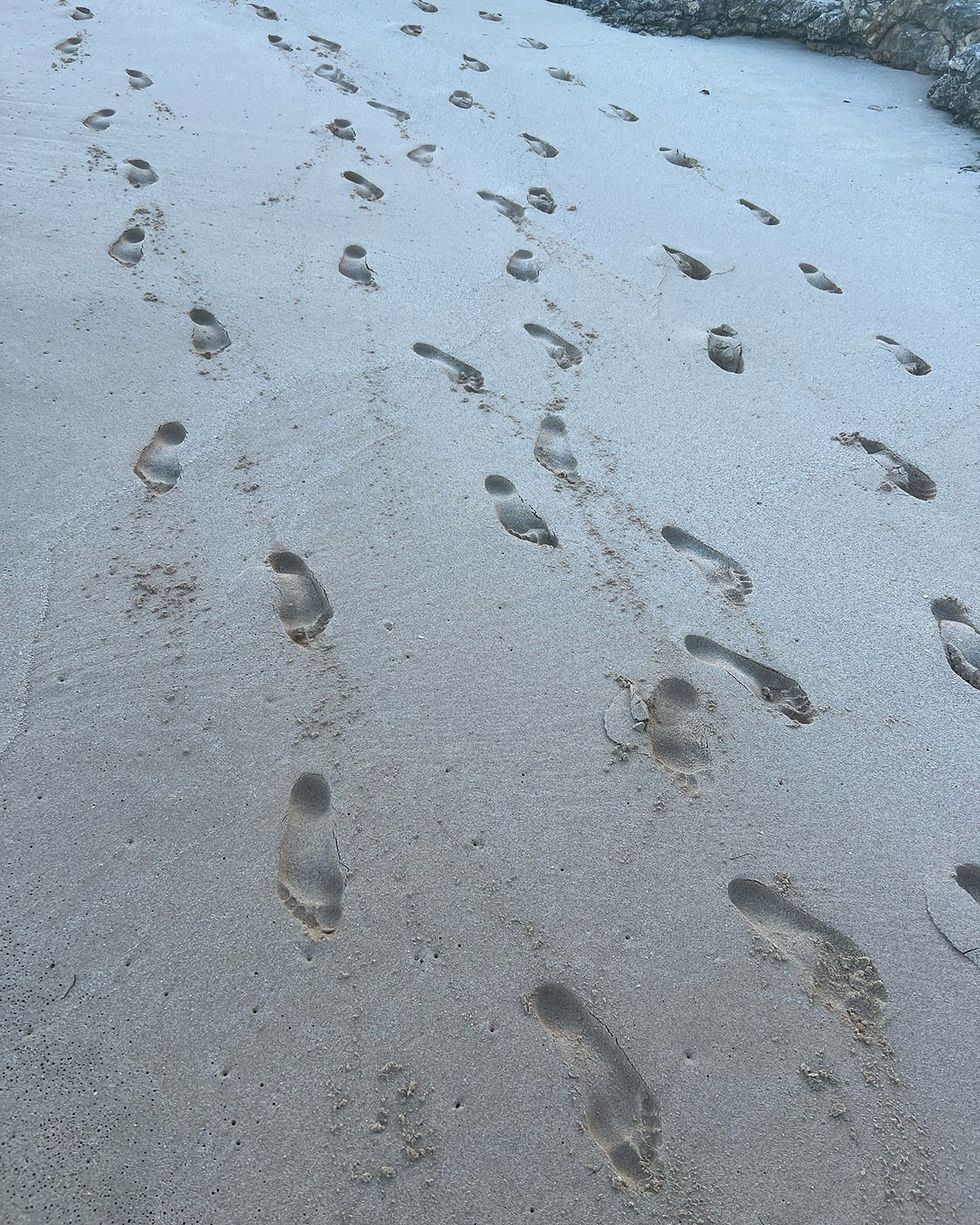In Search of Blue Skies, Biomarkers, and Travertine Fever Dreams in Anguilla
A lesson in enlightenment on the shores of Barnes Bay at the Sensei Pop-up at the Four Seasons Anguilla.

We were greeted by the trademark prismatic Caribbean clouds as we glided into Anguilla over obscenely blue water. I’d heard that the Four Seasons Anguilla was one of the most beautiful of the brand’s properties, but taking in the white sands and lush greenery of the island, it was hard to believe that any manmade structure could compete. Turns out, it didn’t need to compete: it just needed to be so subtly and conscientiously designed so as to perfectly blend in with the stunning natural landscape.
The Four Seasons hotel is a masterpiece of symbiotic architecture, every sweeping view framed and embraced—never blocked—with open, airy design and simple lines that contrast beautifully with the craggy rocks and curving beaches. Kelly Wearstler’s interiors are a travertine fever dream, perfectly complementing the minimalist architecture with elements that mimic sunbleached wood and weatherworn stone. Even the path to the private villas melds seamlessly with the natural topography, gently winding through the plumeria like an ancient footpath carved by native animals (instead of one specifically for golf carts). The villa itself was organic, breezy perfection, huge and modern yet warm and inviting. Even if the treatments from Sensei—the tech-informed wellness company whose residency I had come to experience—had been a bust, a couple of days in my massive bathroom with an adjoining outdoor shower or out by my private infinity pool would have been plenty therapeutic.
The path to the private villas melds seamlessly with the natural topography, gently winding through the plumeria like an ancient footpath carved by native animals.
I had drinks in the Sunset Lounge on my first night (despite intermittent sprinkles, the open-air lounge lived up to its name) before heading to Salt, the hotel’s fine-dining Caribbean restaurant named for Anguilla’s industry of salt harvesting. We were accompanied by Tiffany Moore, a representative of the hotel who began by guiding us through the menu. I would learn two things over the next few days: first, that Anguillans are some of the nicest, most fun people on the planet, and second, that they are amazing chefs. That night we feasted on buttery-sweet giant crayfish, oxtail croquettes, goat curry, luscious branzino, and an astoundingly delectable mac and cheese made with short rib and housemade moringa pasta, all accompanied by hot, tender johnny cakes slathered in fresh butter and sprinkled with herbed Anguillan salt.
Moore told us about the history of the island and the property, and the conversation veered into lively discussions of Anguillan boat racing, movies, piracy, and more. At one point, she turned to me and asked seriously: “Do you believe in the Kraken?” I’d been waiting my whole life for that conversation. We agreed on a shared belief in giant squid and drunk sailors. I left the table painfully full and with new friends, the primary takeaways from most of my interactions on the island.

Courtesy of Kelsey Eisen
I fought back my food hangover the next morning to attend the sprawling breakfast buffet, munching on fresh donuts while taking in the view over Meads Bay, an uninterrupted gradient of deep blue sea and sky like a cerulean Rothko. I waited for my morning Sensei appointment—the mysteriously titled “Mindset 1:1 with Biomarkers”—at the Four Seasons spa, lounging on a deck chair next to yet another infinity pool with an incredible view of the sea. I was in heaven and had to keep mentally prodding myself not to relax too hard: if I was here to get my stress levels evaluated, I wanted to make sure they were at my usual 9/10 instead of my Caribbean 0/10.
My sensei for my Mindset 1:1 session was Jim Cahill, the founder of contemplative neuroscience also credentialed in biofeedback therapy. He first hooked me up to a small device that clipped gently onto my earlobe and reported my heart rate variability, or “HRV,” back to his laptop. He explained that HRV is an indicator of stress and relies on our sympathetic and parasympathetic nervous systems to regulate itself. Most people have an overactive sympathetic nervous system, or the “accelerator” for the “fight or flight” response, and an under-stimulated parasympathetic or “braking” system. Our goal in this session, he explained, was to better learn how to engage the “brake.”
My session with Cahill proved that there really is a way to successfully blend tech with the very human concern of wellness—something of which, I’ll admit, I was originally a bit skeptical. As a Californian, I’ve heard endless lofty promises from both tech and wellness brands, and am accordingly cautious when it comes to their abilities to fulfill them. However, Cahill’s approach of applying his scientific background as a brain researcher to the study of ancient mindfulness practices filters out the BS. Many studies have scientifically validated the mindfulness methods of monks and other contemplatives—for example, Cahill spoke of how the brain scans of accomplished monks are most similar to those of “extremely positive” children.

Courtesy of Kelsey Eisen
One of the tenets of Cahill’s philosophy is “elegance, not dysfunction,” and he uses this to make it clear that your stress responses are simply your body acting as it was designed—not a moral failing. We spoke about how stress shows up in my life, and I found myself emotionally dumping about the stress of a recent career change, my various anxieties, and my tendency to catastrophize. We talked about my scarring experience as a divorce lawyer working with wealthy tech families, and his own experiences in the tech wellness space. We spoke about how people who have everything can still feel empty.
Cahill engaged with every concern, sharing his professional wisdom and making sure I knew these kinds of stress responses were normal. He listened with profound empathy and understanding, explaining the science behind phenomena like amygdala hijacks and making it clear that my spirals are not personal failures but logical physiological responses that I could work to control. We practiced his patented breathing exercises, and I was proud to see my smooth, consistent rhythms on the HRV readout, so different from the spiky mess of my previous input. Slowly but surely, I felt a fog lifting, as though Cahill had coaxed me unknowingly to the top of a mountain by simply coaching me to put one foot in front of the other, I had a realization about some recent stresses that even my therapist hadn’t been able to tease out.
I felt a fog lifting, as though Cahill had coaxed me unknowingly to the top of a mountain by simply coaching me to put one foot in front of the other.
I don’t want to give away the farm here and disclose all of Cahill’s insights, but suffice it to say I highly recommend setting up a Google alert for his name and keeping an eye out for his upcoming book. I spent the afternoon after my session on a beach chair slathered in complementary orange blossom-scented sunscreen, looking out at the powder-white sand of Barnes Bay and thinking how lucky I was to have such profound happiness to be stressed about losing in the first place.
That night I had dinner at the Sunset Lounge, indulging in absurdly delectable sushi and the best take on General Tso’s chicken I’ve ever tasted before enforcing a bedtime appropriate for my early-morning yoga session. I was glad I did, as the yoga teacher—who, as rumor had it, had been the personal yoga instructor to Dubai royalty—absolutely kicked my ass. I nursed my bruised ego and throbbing pecs over the fluffiest pancakes at the hotel’s Bamboo Bar & Grill, musing about how jacked and flexible Dubai royalty must be. Luckily I had my massage session right after, a “Thermal Body Mapping and Massage” treatment. I had been curious what this thermal mapping device was and, just as my imagination was running a bit too wild, was relieved to see it was just a camera.

Courtesy of Kelsey Eisen
The massage was another example of what I was coming to expect from Sensei: an illuminating experience augmented by great conversation with a knowledgeable expert. My masseur John started by offering me a choice of bespoke massage oils, four separate blends with scents inspired by the four elements (as a sucker for sandalwood and vetiver, I picked “earth”). He then explained the process and how the camera would map my body, showing in red the areas that were most tense. I was surprised at how accurate the images were. Obviously, my plane-warped back lit up like the fiery mouth of hell—but so did the tiny spot on the inside of my right knee where I’ve consistently gotten twinges since I was ten years old. As John massaged me into corpse-like relaxation, we got into a deep discussion of our thoughts on movement, mindset, and physicality. I left the session loosened up, smelling amazing, and with one more new bestie to add to the Anguilla tally.
The rest of my stay was so thoroughly pleasant and relaxing, it did have me wondering for a bit how much of my improved mindset was Sensei and how much was just the Four Seasons Anguilla being the ultimate in hospitality. I did a rum tasting where I discovered my new favorite sippable spirit (Anguillan Pyrat) and a ceviche-making class with the resort’s impressive executive chef, Emmanuel Calderon, whose special ingredient inspired by his childhood on the Yucatan peninsula made it the most complex and flavorful version of the dish I’d ever had. (Chef Calderon also confirmed that yes, Anguillans are the best chefs he’s ever worked with.) I then lazed around the pool at the villa, trying to work up my appetite for the private dinner to be held in the backyard. I gorged myself on conch fritters and pineapple rum cakes before waddling over to the Sunset Lounge to catch some of the live performance, where my food coma unfortunately set in with a vengeance after about five minutes. I headed back to pass out before my last Sensei session, a 7 a.m. walking meditation on the beach.

Courtesy of Kelsey Eisen

Courtesy of Kelsey Eisen
I’m not going to lie and say I was in a great mood when I woke up at 6:45 a.m. In fact, I’m going to be completely honest and say I was feeling pretty bitchy. Once on the beach, its white sand blue in the early-morning light, our meditation guide began inviting us to check in with our senses one by one: sound, smell, touch, etc. I was, sadly, too cranky to concentrate on any of them. I was fully aware I was being an unconscionable brat by being in any sort of a bad mood on a gorgeous Caribbean beach, and decided to try implementing some of my new tools.
Using the “elegance, not dysfunction” mantra, I forgave myself for my fussy, hungry failure to achieve oneness with nature and let my mind wander. I entertained myself by trying to walk in other people’s footprints as we strode up and down the breach. As I galumphed through the sand playing my little game, random thoughts began drifting through my mind. After a bit, without effort… they drifted away completely. I realized I was—shockingly—actually meditating. Suspended in time, I heard only the waves, smelled only sea salt, saw nothing but the arching blue of the sky and the undulating cobalt of the water. I left that session the same way I left my experience with Sensei and the Four Seasons Anguilla: relaxed, happy, and inadvertently enlightened.
Note: Sensei has two wellness retreat resorts that are available for booking year-round, on the secluded Hawaiian island of Lānaʻi at Sensei Lānaʻi and near Palm Springs at Sensei Porcupine Creek.




